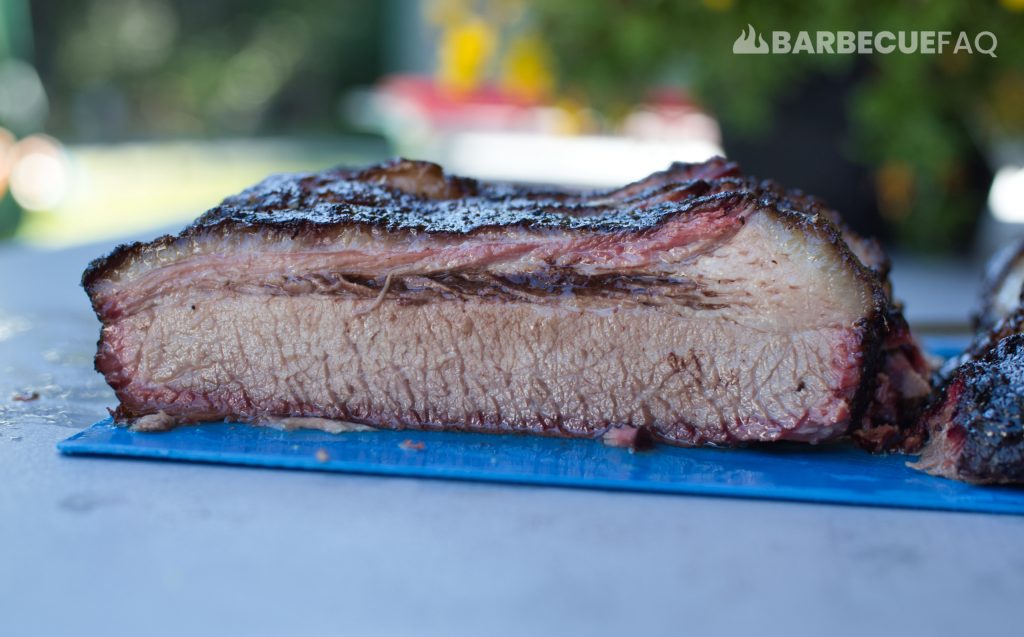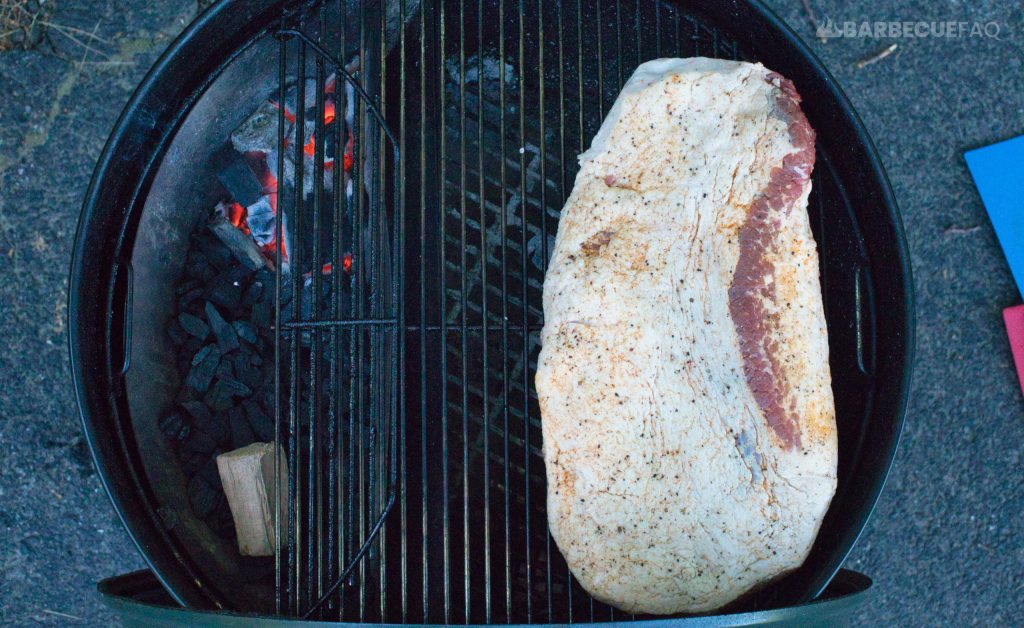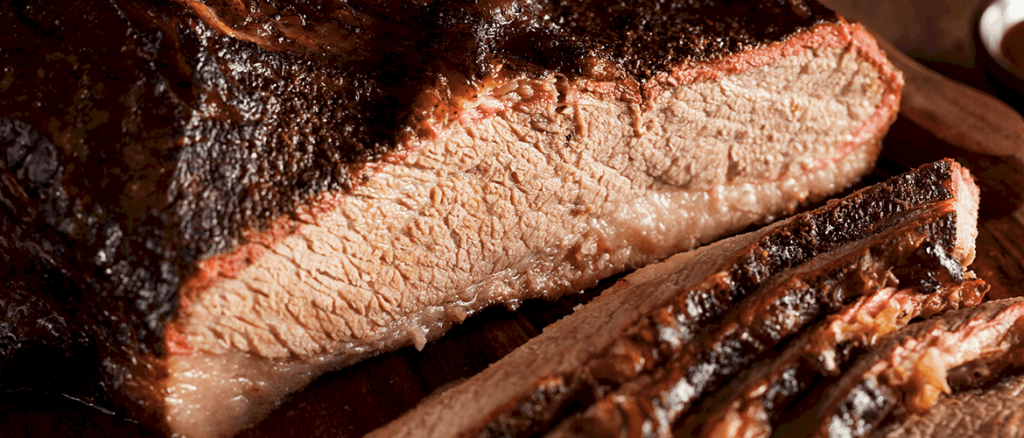I find low and slow brisket to be far better than hot and fast brisket.
The fat is rendered better and the meat simply tastes better.
Low and Slow = 225-275F for 12+ hours; Better fat render and more tender meat.
Hot and Fast = 275 – 325F for 4-6 hours; Faster cook time.
Unbiased Opinions with Regards to Low and Slow and Hot and Fast Brisket
There are a few different pain points for each of these methods.
Click to Jump to Each Section:
Time to Smoke
Low and slow brisket obviously takes much longer than hot and fast brisket.
The first brisket pictured below weighed ~9 lbs trimmed was smoked low and slow for 8 hours and 30 minutes.

Typically at around 225 – 275F, it takes me 1 – 1.25 hours per pound of meat.
Where-as with a hot and fast brisket, you’ll finish 1/3 or 1/2 the time; Typically in the range of 4-6 hours for a 10 lb brisket.
The brisket below weighed ~11 lbs trimmed and finished smoking in 6 hours.
So this brisket weighed 2 lbs more and finished 2 hours faster.

Important Note: Regardless of method being used, both briskets still need to rest.
This typically takes around 1-2 hours.
- If you don’t have time and you’re eating the same day – hot and fast is your only option.
- If you have time – low and slow brisket tastes better
Ease of Smoke
The ease of smoke has to do with things like:
Click to Jump to Each Section:
Temperature Control
This aspect more-so has to do with how experienced you are with YOUR cooker.
On something like a pellet grill you’re simply pressing buttons to reach certain temperatures.
With a charcoal smoker you’re adding charcoal and then adjusting intake and exhaust dampers to reach a certain temperature.

Often it’s harder for beginners to smoke low and slow. With hot and fast you can leave your vents open and add more charcoal to start.
Dealing with the Stall
Regardless of ambient temperature of the smoker, the brisket is going to sweat and will stall, no matter what.
People who smoke hot and fast will experience less of a meat stall than low and slow.

Most people who do “hot and fast” cooks will wrap in foil.
The foil traps humidity and pushes past the effects of evaporative cooling (meat sweating) much better than paper or a foil boat.
People who smoke low and slow will typically opt to:
- Wrap in butcher paper to preserve bark
- Not wrap the meat – to completely preserve the bark
- Foil boat the brisket – to preserve the bark on the fat cap
And yes, Low and Slow Perople also wrap in foil too.
Fat Cap Orientation
With hot and fast cooking you need to be more conscious of the fat side.
I always do fat side towards the heat source because it’s rendered better.
With hot and fast, the fat can function as protection for the lean meat too.
Here’s the fat side of a brisket I smoked on my Pit Barrel Cooker:

While it may look like parts are “burnt” – they’re not; The fat doesn’t taste bitter at all.
This sort of char is one of the reasons people like brisket on barrel cookers, you get this “grilled” flavor due to being over the heat source.
Rub Selection
While not many people use sugar in brisket rubs – you should still be mindful of using it.
The reason for this is because at temperatures of around 325F+, sugars will start to burn which results in an acrid/bitter flavor – essentially ruining the bark.
Low and slow brisket is below the temperature that this can happen, so you’re safer to experiment with sugar-based rubs.
Fat Render and Taste
This is likely what people are most concerned with.
Taste is the hardest thing to describe – especially on the internet.
I’ll attempt to let my photos tell the story but suffice to say, low and slow brisket offers better tasting meat.
I find the fat is rendered better and the meat is more tender.
Here’s slices from a low and slow brisket:

The seam fat is far better rendered (the white stuff below) and the fat sort of melts into the meat.
To compare, here’s a hot and fast brisket.
You can tell that the fat is less rendered – although we still get that yellow pillowly fat cap on the flat because of direct heat cooking.

Every time I cook or see a hot and fast brisket, the seam fat is often poorly rendered – but that’s simply because it doesn’t have enough time to do so.
This is the fat above that’s sort of “white” and setup within the meat, especially the point.
People won’t eat this and will trim it.
In terms of the Meat Itself
While with both briskets you can certainly bite into the meat and it’s tender, there’s a distinct difference between hot and fast and low and slow.
It’s hard to describe but it’s almost like the hot and fast brisket hasn’t had enough time to physically sweat out the moisture within the muscle fibers – giving them more rigidity, even though the meat is still tender.
Meaning it will pass all of your tests:
- Bend tests
- Tear tests
- etc.
But when biting into it, there’s simply less resistance in a low and slow brisket – which will borderline melt in your mouth.
These descriptors may sound nuanced but it’s truly the difference between “good” barbecue and “great” barbecue.
What About Going Hotter and Faster?
The above stands to reason, why not go hotter and faster.
If you were to cook a brisket like a steak – you could certainly get the internal temperature to 195-205F (typical finishing temperatures for smoked brisket).
However, there’s almost no chance the meat is tender.
This is why the temperature and time combination are important.
Without sufficient time held within those temperature ranges the collagen/connective tissue won’t gelatinize and become tender.




